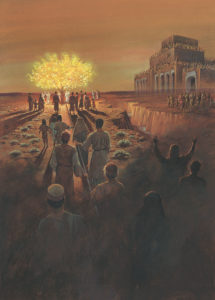Three Times in Three Months
Shortly before he was called to be a member of the Quorum of the Twelve Apostles, Elder Neil L. Andersen was asked to deliver one of the weekly devotionals held every Tuesday at Brigham Young University in Provo, Utah. During his address, which he delivered on March 4, 2007, he explained that speakers select their own topics as they feel impressed by the Lord, and as he started preparing his remarks near the beginning of January that year, he decided to discuss the importance of holding fast to the rod of iron as related in Lehi’s vision in the Book of Mormon. However, he was surprised when he found out that this same topic had also been chosen by two other speakers (both Apostles) just a few weeks before his devotional.
On January 16, 2007, Elder Boyd K. Packer delivered a message, entitled “Lehi’s Dream and You,” centered around Lehi’s dream and the rod of iron. Just three weeks later, on February 4, 2007, Elder David A. Bednar also highlighted the rod of iron and Lehi’s dream in his talk, “A Reservoir of Living Water.” Elder Andersen discussed with Elder Bednar if he should change his message, but Elder Bednar thought a moment and said, “The Lord loves the young adults of the Church. There is purpose in this. This is a message the Lord wants delivered.” As he explained in the opening of his talk, entitled “Hold Fast to the Words of the Prophets,” Elder Andersen proceeded to also discuss Lehi’s dream and the rod of iron as he had planned, and he observed, “My brothers and sisters, this is a subject the Lord wants you to think about.”
Lehi’s Vision
Indeed, Lehi’s Vision of the Tree of Life sits prominently in the opening pages of the Book of Mormon (page 15 out of 531 pages). Not only does Lehi describe his dream in chapter 8 of 1 Nephi, but Nephi is also privileged to see the vision in chapter 11, and then Nephi explains the meaning to his less spiritually mature older brothers in chapter 15. Clearly, as the prophet Mormon and his son, Moroni, saw our latter days and compiled the plates of brass, this vision must have such significant meaning and impact for our day that it was purposely included in the beginning of the book.
For those not familiar with this remarkable vision of the prophet Lehi, he shared this dream with his family and applied it to their lives. The dream consisted of the following symbolic elements:
1 Nephi 8:4, 8 — At the beginning of the dream, he found himself in a dark and dreary wilderness, and after travelling many hours in darkness, he began to pray to the Lord for mercy and deliverance. Inerestingly, the vision did not start until after he said a prayer.
1 Nephi 8:10 — Lehi beheld a tree, whose white fruit was “desirable to make one happy” and “it was most sweet” and filled his soul “with exceedingly great joy.”
1 Nephi 8:13 — a river of filthy water ran along near the tree.
1 Nephi 8:19 — a rod of iron extended along the bank of the river and led to the tree.
1 Nephi 8:20 — a strait and narrow path ran along beside the rod of iron.
1 Nephi 8:23 — a mist of darkness arose from the river and obscured the path, tree, and all those commencing along path.

Lehi’s Dream, by Jerry Thompson. Courtesy of the LDS Church, © 2015 by Intellectual Reserve, Inc. All rights reserved.
1 Nephi 8:26-27 — Across the river Lehi beheld a “great and spacious building; and it stood as it were in the air, high above the earth.” This building was filled with many people, old and young, male and female, clothed in fine apparel, who were “in the attitude of mocking and pointing their fingers towards those who had come at and were partaking of the fruit.”
Three Groups on the Path
Although many people were pressing forward, some towards the great and spacious building, some into the river, and some into “strange roads,” there are three groups in particular pressing forward along the strait and narrow path towards the tree of life and its fruit who are highlighted and contrasted.
(1 Nephi 8: 21-23) Group #1 started on the path, but when the mists of darkness arose, they lost their way, wandered off, and were lost. There is no mention of the iron rod in these verses, and although this group started on the path with some element of faith in Christ, they became distracted by temptation of the devil and were lost.
(1 Nephi 8:24-28) Group #2 commenced on the path and pressed forward through the mists of darkness by clinging to the rod of iron until they eventually reached the tree and partook of the fruit. Unfortunately, even after obtaining the fruit, this group also became lost as they were confronted with adversity and persecution from those in the great and spacious building.
(1 Nephi 8:30) Group #3 also reached the tree by pressing forward along the path while continuously holding to the rod of iron. Not only did this group hold fast to the iron rod, but once they reached the tree, they fell down and partook of the fruit.
The key difference between all three groups is their interaction with the rod of iron. The first group did not hold to the rod at all, and once the mists arose, they became lost and none reached the tree. The second group was described as “clinging” to the iron rod, wherein the last group was described as “continually holding fast” to the iron rod.
The dictionary defines clinging as “tenaciously holding tightly” or “adhere as if glued firmly,” which seems to suggest holding on for dear life. Likewise, the last group was “holding fast,” but the word “fast” is not necessarily used to describe the speed with which the rod was grasped, but an alternate meaning is defined as “firmly fixed in place” or “not easily moved.” This meaning of the word “fast” is often used when describing a gate, or door, or button as being “securely fastened.” So it would seem that both groups were holding tightly to the rod, so what is the difference between clinging versus holding fast to the rod of iron?
Clinging is Not Enough
During his address at BYU, Elder David A. Bednar explained the difference as follows:
“Clinging to the rod of iron suggests to me only occasional ‘bursts’ of study or irregular dipping rather than consistent, ongoing immersion in the word of God…. [the] third group of people consistently read and studied and searched the words of Crhist. Perhaps it was the constant flow of living water that saved the third group from perishing. This is the group you and I should strive to join.” (“A Reservoir of Living Water,” Elder David A. Bednar, BYU Speeches, Feburary 4, 2007.)
As such, the primary problem lies not necessarily with how tightly the last two groups were grasping the rod of iron — both groups were holding the rod firmly — but the key difference appears to be more with the consistency or amount of time the rod was being grasped. At times, we may let go of the iron rod because we are too busy, or feel we are strong enough to let go occasionally, but as the mists of darkness slowly intensify around us, if we do not continually hold fast, we may find that it is too late. We reach out to cling to the rod only to find we have lost our way.

We must continually hold fast and never let go. Courtesy of the LDS Church, © 2015 by Intellectual Reserve, Inc. All rights reserved.
May we continually hold fast to the words of Christ and take time each day to read and study and pray from His living water. That will be the only way that we and our families may safely navigate the mists of darkness around us, so that we may partake of the fruit of the tree, which is the gospel of Christ, which is desirable above all other fruit and as Lehi testified, will truly “make one happy.”
Promised Blessings
I would encourage all to read these wonderful scriptures and speeches, but just a few promises, warnings, and blessings to pay particular attention to:
The prophet Nephi promised: “Whoso would hearken unto the word of God, and would hold fast unto it, they would never perish; neither could the temptations and fiery darts of the adversary overpower them unto blindness, to lead them away to destruction.” (1 Nephi 15:24)
Elder Boyd K. Packer warned:
- “… Lehi’s dream or vision of the iron rod has in it everything a young Latter-Day Saint needs to understand the test of life.”
- “… At your baptism and confirmation, you took hold of the iron rod. But you are never safe. It is after you have partaken of that fruit that your test will come.”
- “… You who are young will see many things that will try your courage and test your faith. All of the mocking does not come from outside of the Church. Let me say that again: All of the mocking does not come from outside of the Church. Be careful that you do not fall into the category of mocking.” (“Lehi’s Dream and You,” Elder Boyd K. Packer, BYU Speeches, January 16, 2007.)
Elder David A. Bednar observed:
- “… Thirst is a demand by the cells of the body for water, and the water in our bodies must be replenished daily. It frankly does not make sense to occasionally ‘fill up’ with water, with long periods of dehydration in between. The same thing is true spiritually. Spiritual thirst is a need for living water. A constant flow of living water is far superior to sporadic sipping.” (“A Reservoir of Living Water,” Elder David A. Bednar, BYU Speeches, Feburary 4, 2007.)
Elder Neil L. Andersen testified:
- “The iron rod is the word of God. The scriptures, the words of the living prophets, and the gift of the Holy Ghost are powerful in their ability to keep us safe. Let us hold fast to the words of the prophets. Let us hold fast to the iron rod.” (“Hold Fast to the Words of the Prophets,” Neil L. Andersen of the Presidency of the Seventy, BYU Speeches, March 4, 2007.)
